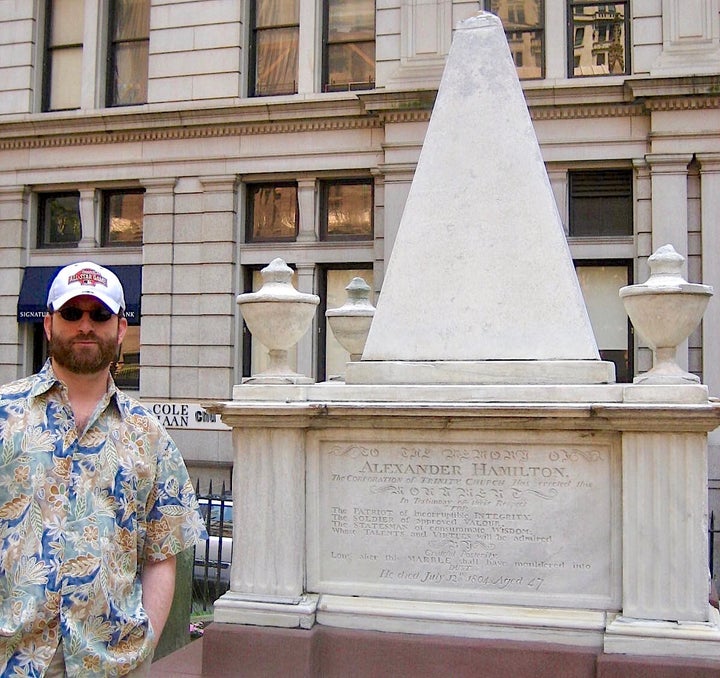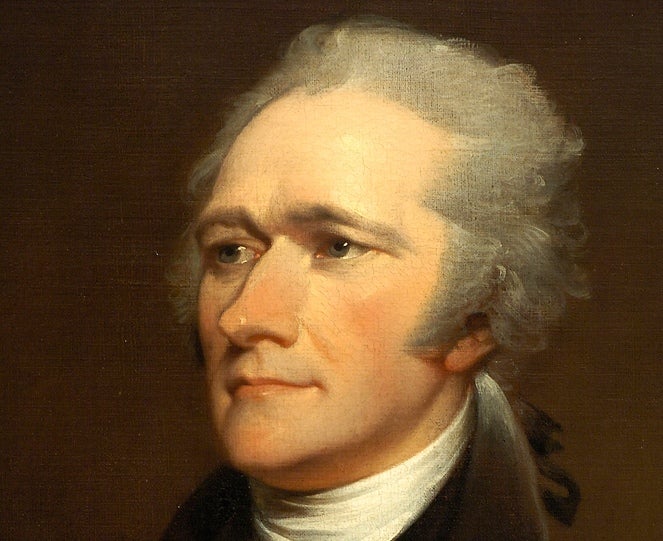
This is a travelogue, my search for Alexander Hamilton's Caribbean roots.
Admittedly, Alexander Hamilton is a strange subject for a tech writer. But I also am a tech historian, and historians in general are interested in all history, not merely their specialty – historians are always chasing new contexts and perspectives.
As such, it could be argued that Alexander Hamilton is a key figure in tech history. Hamilton's prescient and influential 1791 "Report on the Subject of Manufactures" to Congress is a blueprint of how government can, should and does foster industry, innovation and entrepreneurialism.
Unlike most Americans, Lin-Manuel's startling musical was not my first introduction to Hamilton. I had already read three other bios of him, and devoured "Alexander Hamilton," Ron Chernow's compelling and comprehensive bio, the day it came out. As a New Yorker, I'm a frequent visitor to both Hamilton's Harlem home, the Grange (in both its past and current locations), as well as his appropriately located grave at Trinity Church at the foot of Wall Street, the symbol of the American economy Hamilton invented. My wife and I also visited the Weehauken site of his 1804 duel with Aaron Burr.
An ad my wife spotted in the Playbill for "Hamilton: An American Musical" prompted us to seek Hamilton's Caribbean origins in Nevis, where he was born, and St. Croix, where he grew up, to see how these dots in the middle of the ocean shaped arguably our most influential and fascinating founder.
Saint Kitts/Nevis
Our first stop was the independent nation of St. Kitts and Nevis, population around 56,000, a 45-minute puddle-jumper flight from San Juan, Puerto Rico. Like many Caribbean islands, St. Kitts, a shortened version of St. Christopher, presents a disturbing dichotomy. Along its eastern, Caribbean shore, north of the cruise ship-catering capital, Basseterre, are a series of skinny ramshackle villages, comprised of crumbling concrete houses, many originally built for the sugar cane workforces, both slave and eventually free. Along its western Atlantic shore are a series of resorts and hotels of varying luxury.
Hamilton must have visited St. Kitts, but there is no indication on the island that he did. So, my wife and I took the ferry from Basseterre to Charlestown on Nevis. Greeting visitors is "A Welcome to Nevis: Birthplace of Alexander Hamilton" arch. A mere two-minute walk from the pier along the waterfront is Hamilton's actual birthplace site, represented by a simple, nondescript clapboard house that obviously does not date from the 18th century, but which houses a Hamilton exhibit.
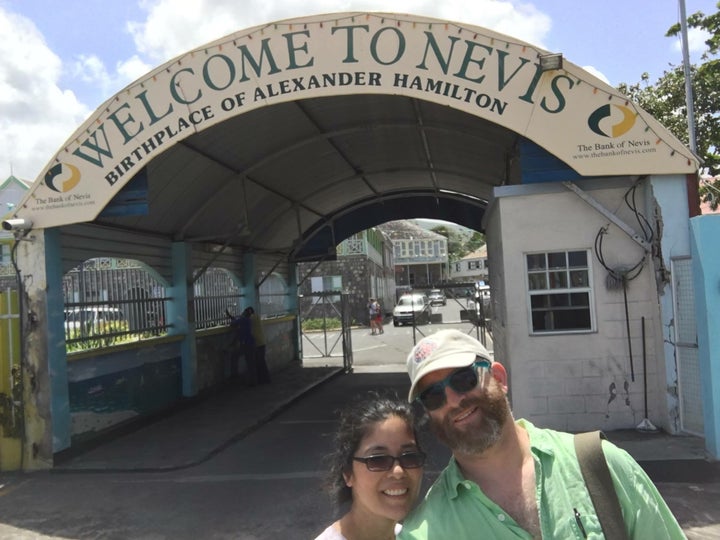
Across a yard from his birth house is a two-story stone building that houses both a small Hamilton museum in the sub-level first floor and Nevis' governmental administration on the second. A couple of commemorative plaques adorn a stone wall that borders the site's landward side.
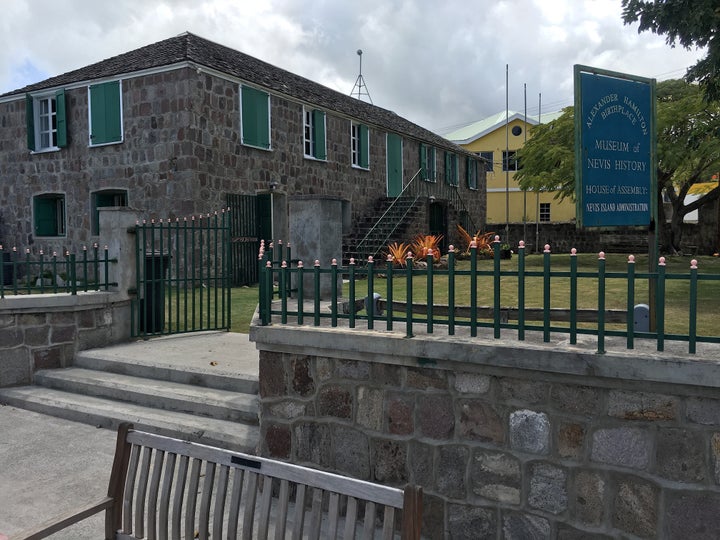
There is no other sign of Hamilton on the rest of the small island. It took less than an hour to exhaust Nevis' Hamiltonian attractions.
Via another puddle jumper from St. Kitts (Nevis has no airport), we absconded to St. Croix, which proved both more fruitful and yet more disappointing for Hamilton seekers.
Like St. Kitts, the larger and more prosperous St. Croix, population around 50,000, is a mix of tourist-centric prosperity and abject poverty – all within a several block area in its capital, Christiansted, centrally located on the island's southern shore.
According to Chernow, Hamilton's mother, Rachel Faucette Lavien, also born on Nevis, left her first husband in 1750, five years before Hamilton was born. In revenge, the cuckold sent his wayward wife to jail for several months in St. Croix' Fort Christiansvaern. Located at the western end of town and brightly repainted a deceptively cheerful butterscotch yellow and white, Rachel's former 10 x 10-foot windowless cell now houses informational posters.
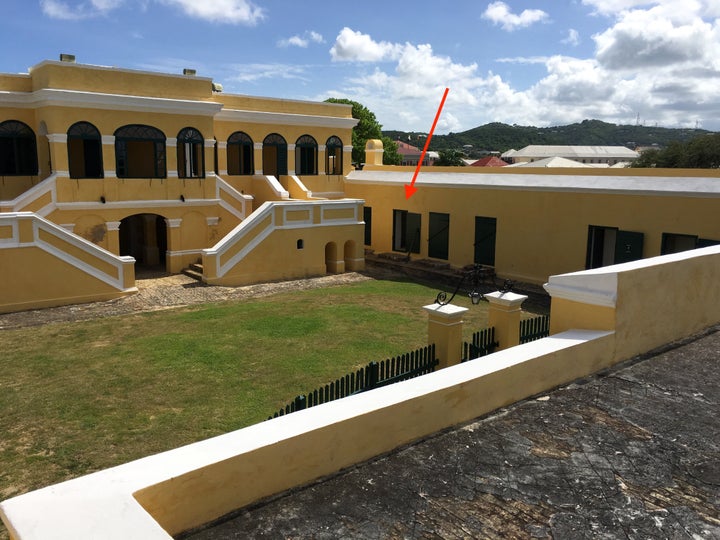
Once out of jail, Rachel hooked up with James Hamilton, the ne'er-do-well third son of a Scottish laird, with whom she had two illegitimate boys, Alexander and James Jr. After being abandoned by their father, Rachel moved with her children to a two-story building at 34 Company Street "in the wooden upper floor, which probably jutted over the street," according to Chernow. She then moved down the street to 23 Company Street, then back to 34, where she died in 1767 of a fever that Hamilton himself barely survived.
We could find neither address. We visited the government offices where a polite clerk showed us a contemporary real estate map, but she acknowledged that the address numbering had likely shifted over more than two and a half centuries. In all events, this end of Company Street, one of Christiansted's main drags and just a few blocks from the bustling waterfront tourist zone, looks like the remnants of a war zone. Most of the two-story buildings along the far end of contemporary Company Street were abandoned and boarded up, strewn with refuse and graffiti – an embarrassment, considering the tourist taxes and fees the government rakes in.
After their mother died, the two Hamilton boys were taken in by Rachel's cousin, Peter Lytton, and moved to his plantation north of Christiansted, The Grange. But 18 months after being appointed guardian, cousin Peter committed a bloody suicide. The two orphaned brothers were then taken in by a local merchant, Thomas Stevens, who had five children of his own. The Stevens lived on prosperous King Street, near Fort Christiansvaern. It is unclear if the building on the spot is the Edward's original home (I doubt it), but the nearly empty banana yellow building on the site of where Hamilton lived for the next six years unfortunately bears no notice of its illustrious former occupant.
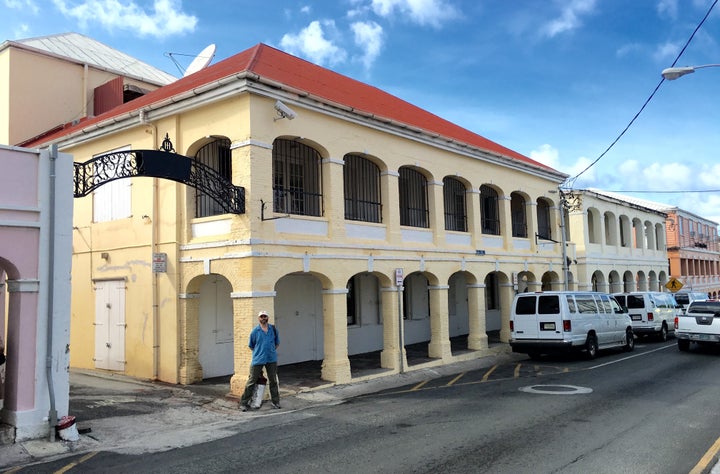
Across the street from the Edward's home is St. Croix' Government House. After explaining our mission – and expressing disappointment in St. Croix's lack of Hamilton markings – an official let us browse around upstairs, where a small portrait of Hamilton hangs at one end of a long banquet/reception room.
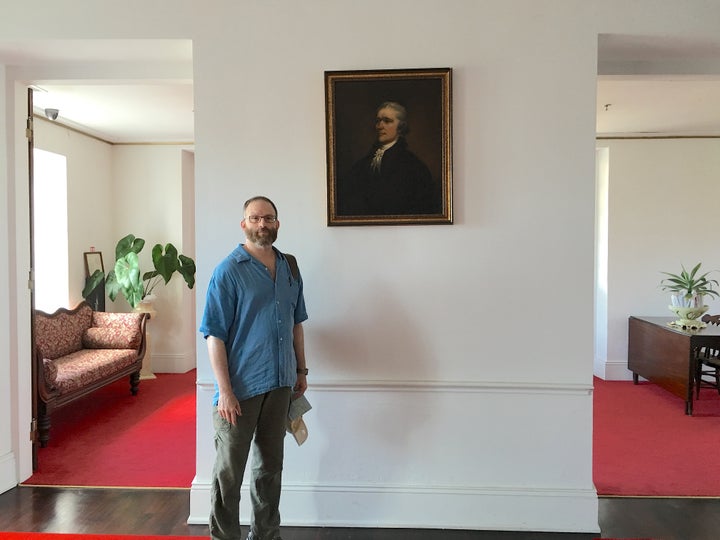
We then wandered down King Street, searching for where Hamilton clerked at "the mercantile house of Beekman and Cruger, the New York traders who had supplied his mother with provisions…[l]ocated above the harbor at the elevated intersection of King and King's Cross Streets," according to Chernow, just a block away from the Edwards' home. We easily found the spot, thanks to the only plaque we could find on the whole island acknowledging Hamilton's presence.
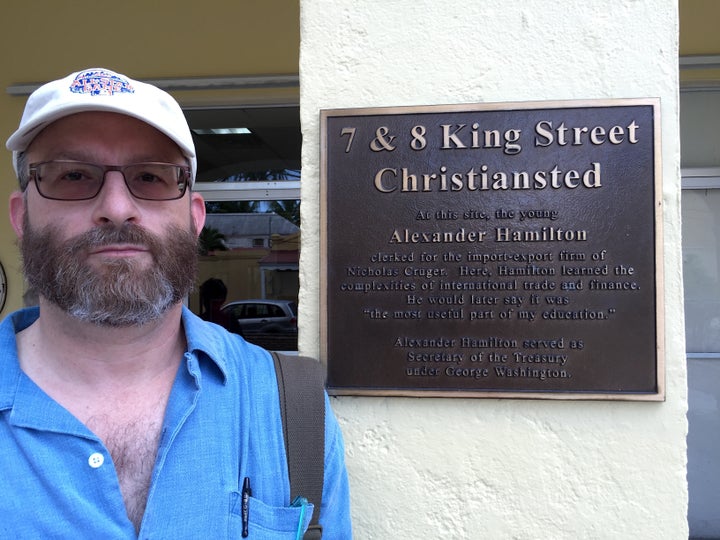
Finally, we wanted to find Rachel's grave. Chernow only says she was buried at The Grange – he gives no actual location, and local maps provided only area labels.
Armed with only these vague clues, we queried three successive cab drivers, the third indicating he thought he knew where we wanted to go. After a 15-minute drive on a major highway and a left turn onto a hidden, winding gravel road through what seemed a well-kept orchard, we spied a plain, white house atop a small hill. To the left of the front door was a clay tablet inscribed with the year 1761 – this must be the place.

We were told the house was privately owned; we knocked on the door, but got no answer. Some workmen in the yard pointed out the small cemetery behind the house, where, just as Chernow describes, "beneath a grove of mahogany trees," we found Rachel's grave.
While happy to find this hidden gem, we were disappointed in the reality. The tombstone was obviously not original. Worse, it misspelled all three of her names; instead of "Rachel Faucette Lavien" the stone reads "Rachael Fawcett Levine," a final slap at the memory of this troubled woman.
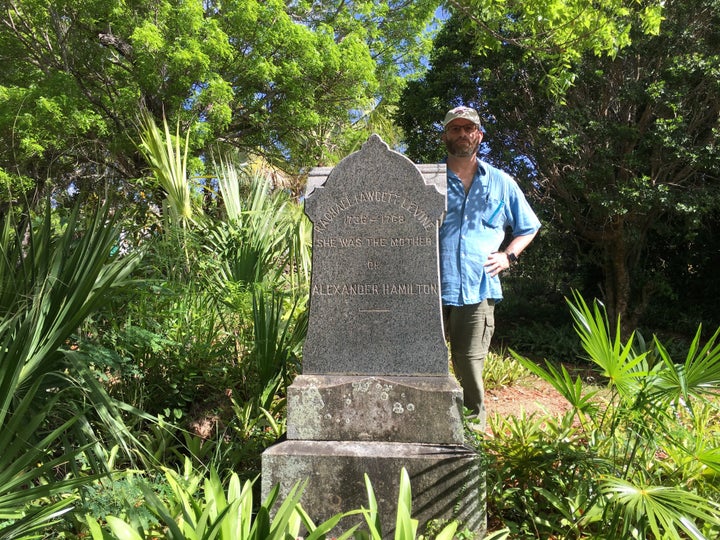
Upon Further Review
It's astounding and disappointing how little Nevis and St. Croix have exploited their native son's newly-found fame. Almost as a final insult, when departing St. Croix for home, an airport security guard told us that the airport had been originally named for Hamilton, but then renamed in 1996 for a native who became a WWII Tuskegee Airman.
Upon further contemplation, however, it was the cumulative impact of the environment and history of the three islands themselves than anything specific to Hamilton that enhanced my appreciation of my favorite founding father and his later accomplishments, and that made the trip fulfilling.
In particular, it was the still visible and ubiquitous remnants of the Caribbean's vicious sugar cane slavery and its effect on Hamilton that had the deepest impact on my appreciation of him.
Slavery in the western hemisphere can be divided into three types of increasing levels of nastiness: the 18th century pre-cotton gin era, centered primarily on tobacco and rice, mostly along the Atlantic coast – Maryland, Virginia, the Carolinas; the cotton-centric slavery of the pre-Civil War 19th century centered more in the deep south – Louisiana, Mississippi, Alabama, Georgia; and, the sugar and coffee-centric slavery of the Caribbean and South America.
Historians agree that 18th century sugar plantation slavery was the worst of the worst, with slave life expectancy averaging just 7-9 years. And St. Kitts and St. Croix are littered with the ruined remnants of this vicious slave economy. As Chernow notes:
"No less than in Nevis, slavery was all-pervasive on St. Croix — it was 'the source from which every citizen obtains his daily bread and his wealth,' concluded one contemporary account — with twelve blacks for every white."
Hamilton's exposure to sugar cane slavery is what made him fervently anti-slavery, and prompted him to later help launch the New York Manumission Society, one of the world's first such organizations. As Chernow writes: "Few, if any, other founding fathers opposed slavery more consistently or toiled harder to eradicate it than Hamilton."
But the sugar cane business, supported by slavery, is what provided Hamilton's sponsors the funds to send him to New York to be educated. And the business – and bossing – experience Hamilton gained at Beekman and Cruger, founded on slavery, would prove critical to his later role as the nation's first treasury secretary and Federalist leader.
Overall, Hamilton's adolescent Caribbean experiences gave him a unique, societal, economic and worldly experience compared to his Constitutional contemporaries, who were primarily the provincial products of well-to-do farmers and plantation operators – and slave owners. Seeing Hamilton's adolescent environment first-hand, even nearly 300 years later, gave me a whole new perspective of Hamilton that Manuel barely touches upon. It's what made Hamilton Hamilton.
As Chernow observes: "That this abominable childhood produced such a strong, productive, self-reliant human being — that this fatherless adolescent could have ended up a founding father of a country he had not yet even seen — seems little short of miraculous."
And after visiting his Caribbean beginnings, now I'm beginning appreciate this miracle. And considering Hamilton's unlikely impact on our present, our miracle, too.
